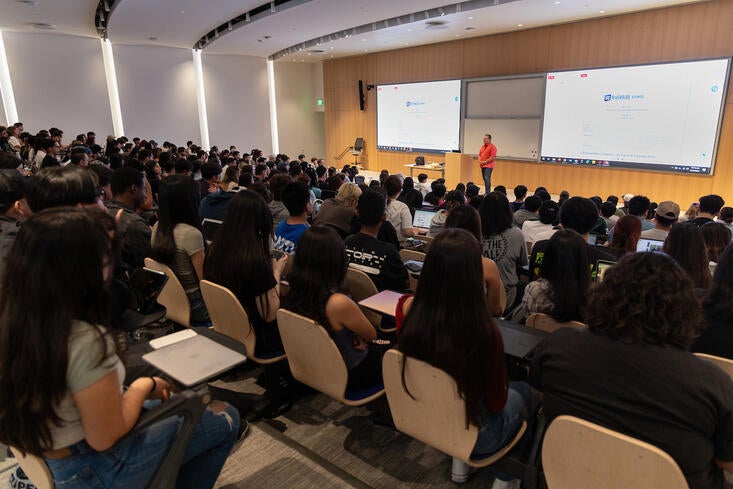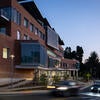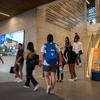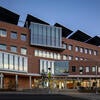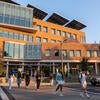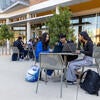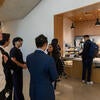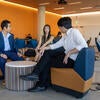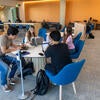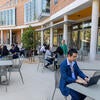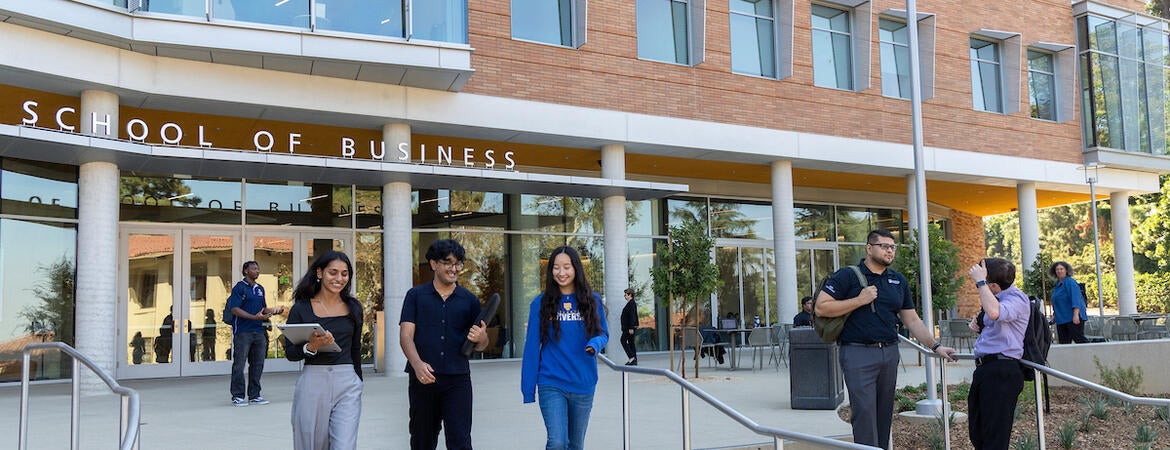
UC Riverside’s School of Business opened its new building in late September, launching a new era at a state-of-the-art facility with increased space to meet fast-growing enrollment.
The four-story, 63,400-square-foot building was already bustling with activity, with students filling its auditorium, classrooms, and the lounge area near its café following the start of instruction on Sept. 26. A ribbon-cutting ceremony and open house celebration will be held Oct. 18.
The $87 million project, which began construction in April 2023, is a key element of the school’s plan to grow its faculty and increase enrollment with a modern building that fosters engagement with the community and business leaders, said Yunzeng Wang, dean of the school.
Wang marveled at the completed project shortly after moving into his new office, where a miniature model of the building sat on his desk.
“It’s very exciting,” he said. “It’s beautiful.”
The new building, which includes classrooms, administrative and faculty offices, and a large auditorium, creates a home base where students can learn, study, socialize, and network with their peers and business leaders in one place, School of Business leaders said.
Until now, the school’s administration had been housed at Anderson Hall, built in 1917 as part of the Citrus Experiment Station that preceded UCR. Due to limited space at Anderson and Olmsted Hall, where program offices were located, many classes have been held in other buildings on and off campus.
The new facility, located in the south side of campus, is next to Anderson, which will continue to have offices and classes. Landscaping, outdoor benches, tables, and a crosswalk were added around both buildings to connect them and create a neighborhood feel.
“Everything is here for the students,” said Kathleen Drake, assistant dean for marketing and communications. “The goal was for them to feel more connected to the school.”
The 350-seat auditorium, which has two 192-inch LED wall monitors and a white board, is unlike any other the school has had in size and technology. It is being used for large classes, lectures, and other events.
The building also includes two 80-seat classrooms, which — like the auditorium — feature hybrid learning technology allowing lecturers to deliver multi-media presentations that can be recorded and streamed. The tiered classrooms feature seating that allows students to face either direction and interact with each other.
“The facility by design really gives that whole vibe of an encouraging, welcoming, and inviting environment to students,” said Sabine Freij, assistant dean of graduate programs for the school. “From every corner in the building, in every floor, you see these open collaboration spaces for students and faculty to sit and build on ideas.”
Administrators, staff, and faculty began moving into the new building in early September and scheduling fall classes there shortly after.
The structure features locally sourced red brick known as UCR Brick, concrete columns, and large glass windows with perforated metal fins on the sides to reduce glare and heat gain. Part of the second floor projects out to shade the outdoor plaza below, while the fourth-floor executive board room features expansive views of the campus, and mountains beyond.
“The view is phenomenal,” said Frank Salhab, project manager with contractor McCarthy Building Companies, which oversaw construction and design. “It gives you a feeling like you’re floating over the campus.”
The first floor opens to an airy lobby with couches and tables next to a small coffee shop called Biz Café. Next to it is a 2,278-square-foot multipurpose room with couches, lounge chairs, and stools that allows for a variety of uses from studying to socializing. The café was a late addition to the project during construction, said John Franklin, project manager with Planning, Design, and Construction. He noted it fills a need in that area of campus, which has few dining options.
A stairwell featuring donor names on the wall leads to a computer and finance lab on the second floor with a stock market ticker on LED displays on both inside and outside walls. The lab, which can be used for individual study or group projects, seats up to 78 people with computer monitors at each seat that rise from inside the desk. Students can access terminals with business and market news and data through the Bloomberg news site for class and research projects and the school’s investment clubs.
Study areas are spread throughout the building including a separate graduate student lounge with amenities like lockers and a kitchen area.
The building has a 216-kilowatt solar array on the roof achieving LEED Platinum-status, meeting leading industry standards for energy efficiency and sustainability. The solar panels began producing energy back into the campus electrical grid a few months ago, Franklin said.
Miguel Aranda, assistant dean and director of undergraduate programs, described the new building as “futuristic but grounded.”
“This is something special,” he said. “It will be a space to inspire students, providing them the technology and space they need.”
Freij said the new space can provide educational opportunities beyond the classroom, whether it’s hosting industry panels or seminars with visiting researchers, or taking part in student competitions in-person or virtually. The large lockers provide enough space for students to keep business attire for interviews or special events.
“We’re finally able to provide this for our students and accommodate the needs and the numbers with modern-day technology and, the standards of other business schools that enable their students to be competitive,” Freij said. “We’re now providing resources and a facility that match those to support students in their education and career endeavors.”
The project blends into the sloped topography of the site so that the second floor leads out to an open courtyard with a hillside view. Between landscaped areas are section walls that can be used for seating to create a mini-amphitheater layout for gatherings.
“The new School of Business building will be the defining first step towards creating a unique district in this area of campus for all to enjoy and will set the stage for inspired and responsible surrounding future development,” said Jacqueline Norman, campus architect.
